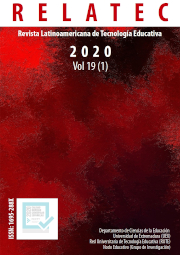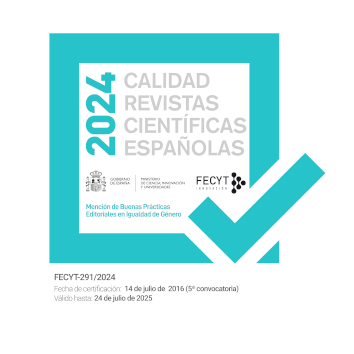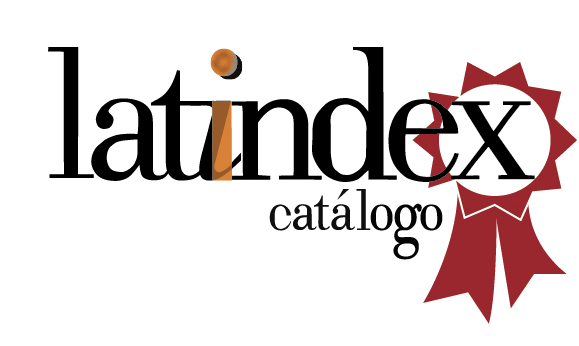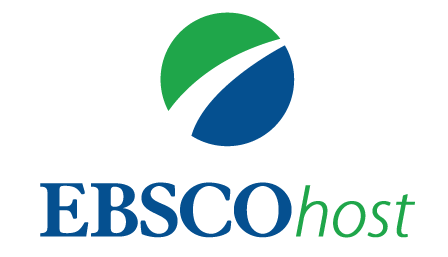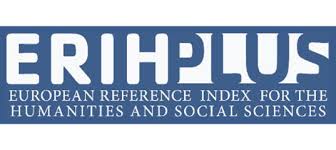Revisión sistemática de las características de gestión del tiempo en la realización de actividades educativas en los sistemas de gestión del aprendizaje.
DOI:
https://doi.org/10.17398/1695-288X.19.1.63Palabras clave:
Gestión del tiempo, Analíticas de aprendizaje, Minería de datos educativos, Revisión sistemática de la literatura, Sistemas de Gestión del AprendizajeResumen
El uso de sistemas de gestión del aprendizaje es cada vez más frecuente como modalidad de enseñanza-aprendizaje. Esto se debe al hecho de que permite una mayor flexibilidad de tiempo y espacio en relación con el aprendizaje presencial. Por lo tanto, este trabajo tiene como objetivo presentar cómo las áreas de minería de datos educativos y análisis de aprendizaje están contribuyendo a extraer conocimiento de la autorregulación de la gestión del tiempo en entornos de e-learning Para esto, consideramos el concepto de gestión del tiempo de Pintrich (2000) y llevamos a cabo una revisión sistemática de la literatura. Fue posible evidenciar que la mayoría de los trabajos analizados no tienen como objetivo investigar sobre la gestión del tiempo, a pesar de que informan sobre resultados. También se observa que los datos que representan la gestión del tiempo, utilizados en la investigación, son datos agregados, es decir, el fenómeno no se estudia con el tiempo. Con estos resultados, tenemos una visión general de cómo el campo de Learning Analytics y Educational Data Mining están contribuyendo a extraer conocimiento sobre la autorregulación de la gestión del tiempo en entornos en línea.
Descargas
Referencias
Bittencourt, I. I., & Isotani, S. (2018). Informática na Educação baseada em Evidências: Um Manifesto. Revista Brasileira de Informática Na Educação, 26(3), 108. https://doi.org/10.5753/rbie.2018.26.03.108
Boroujeni, M. S., Sharma, K., Kidziński, Ł., Lucignano, L., & Dillenbourg, P. (2016). How to Quantify Student’s Regularity? In Adaptive and Adaptable Learning (pp. 277–291). Springer International Publishing. https://doi.org/10.1007/978-3-319-45153-4_21
Broadbent, J., & Poon, W. L. (2015). Self-regulated learning strategies & academic achievement in online higher education learning environments: A systematic review. The Internet and Higher Education, 27, 1–13. https://doi.org/10.1016/j.iheduc.2015.04.007
Cerezo, R., Esteban, M., Sánchez-Santillán, M., & Núñez, J. C. (2017). Procrastinating Behavior in Computer-Based Learning Environments to Predict Performance: A Case Study in Moodle. Frontiers in Psychology, 8. https://doi.org/10.3389/fpsyg.2017.01403
Claessens, B. J. C., van Eerde, W., Rutte, C. G., & Roe, R. A. (2007). A review of the time management literature. Personnel Review, 36(2), 255–276. https://doi.org/10.1108/00483480710726136
Dunlosky, J., & Ariel, R. (2011). The influence of agenda-based and habitual processes on item selection during study. Journal of Experimental Psychology: Learning, Memory, and Cognition, 37(4), 899–912. https://doi.org/10.1037/a0023064
Feldmann, B. (2014). Two Decades of e-learning in Distance Teaching – From Web 1.0 to Web 2.0 at the University of Hagen. In Communications in Computer and Information Science (pp. 163–172). Springer International Publishing. https://doi.org/10.1007/978-3-319-10671-7_16
Hadwin, A., Järvelä, S., & Miller, M. (2017, August 31). Self-Regulation, Co-Regulation, and Shared Regulation in Collaborative Learning Environments. Retrieved from https://www.routledgehandbooks.com/doi/10.4324/9781315697048.ch6
Jo, I.-H., Kim, D., & Yoon, M. (2014). Analyzing the log patterns of adult learners in LMS using learning analytics. In Proceedings of the Fourth International Conference on Learning Analytics And Knowledge - LAK ’14. ACM Press. https://doi.org/10.1145/2567574.2567616
Jo, I.-H., Yu, T., Lee, H., & Kim, Y. (2014). Relations between Student Online Learning Behavior and Academic Achievement in Higher Education: A Learning Analytics Approach. In Emerging Issues in Smart Learning (pp. 275–287). Springer Berlin Heidelberg. https://doi.org/10.1007/978-3-662-44188-6_38
Jo, Il-Hyun & Kim, Dongho & Yoon, Meehyun. (2015). Constructing proxy variables to measure adult learners' time management strategies in LMS. Educational Technology and Society. 18. 214-225.
Kim, D., Yoon, M., Jo, I.-H., & Branch, R. M. (2018). Learning analytics to support self-regulated learning in asynchronous online courses: A case study at a women’s university in South Korea. Computers & Education, 127, 233–251. https://doi.org/10.1016/j.compedu.2018.08.023
Kitchenham, B., & Charters, S. (2007). Guidelines for performing systematic literature reviews in software engineering. Tech. Rep. EBSE 2007-001, Keele University and Durham University Joint Report.
Lee, Y. (2018). Effect of uninterrupted time-on-task on students’ success in Massive Open Online Courses (MOOCs). Computers in Human Behavior, 86, 174–180. https://doi.org/10.1016/j.chb.2018.04.043
Littlejohn, A., Hood, N., Milligan, C., & Mustain, P. (2016). Learning in MOOCs: Motivations and self-regulated learning in MOOCs. The Internet and Higher Education, 29, 40–48. https://doi.org/10.1016/j.iheduc.2015.12.003
Mega, C., Ronconi, L., & De Beni, R. (2014). What makes a good student? How emotions, self-regulated learning, and motivation contribute to academic achievement. Journal of Educational Psychology, 106(1), 121–131. https://doi.org/10.1037/a0033546
Nadinloyi, K. B., Hajloo, N., Garamaleki, N. S., & Sadeghi, H. (2013). The Study Efficacy of Time Management Training on Increase Academic Time Management of Students. Procedia - Social and Behavioral Sciences, 84, 134–138. https://doi.org/10.1016/j.sbspro.2013.06.523
Panadero, E. (2017). A Review of Self-regulated Learning: Six Models and Four Directions for Research. Frontiers in Psychology, 8. https://doi.org/10.3389/fpsyg.2017.00422
Pintrich, P. R. (2000). The Role of Goal Orientation in Self-Regulated Learning. In Handbook of Self-Regulation (pp. 451–502). Elsevier. https://doi.org/10.1016/b978-012109890-2/50043-3
Pintrich, P. R. (2004). A Conceptual Framework for Assessing Motivation and Self-Regulated Learning in College Students. Educational Psychology Review, 16(4), 385–407. https://doi.org/10.1007/s10648-004-0006-x
Rasid, N., Nohuddin, P. N. E., Alias, H., Hamzah, I., & Nordin, A. I. (2017). Using Data Mining Strategy in Qualitative Research. In Advances in Visual Informatics (pp. 100–111). Springer International Publishing. https://doi.org/10.1007/978-3-319-70010-6_10
Siemens, G., & Baker, R. S. J. d. (2012). Learning analytics and educational data mining. In Proceedings of the 2nd International Conference on Learning Analytics and Knowledge - LAK ’12. ACM Press. https://doi.org/10.1145/2330601.2330661
Tabuenca, B., Kalz, M., Drachsler, H., & Specht, M. (2015). Time will tell: The role of mobile learning analytics in self-regulated learning. Computers & Education, 89, 53–74. https://doi.org/10.1016/j.compedu.2015.08.004
Wolters, C. A., Won, S., & Hussain, M. (2017). Examining the relations of time management and procrastination within a model of self-regulated learning. Metacognition and Learning, 12(3), 381–399. https://doi.org/10.1007/s11409-017-9174-1
Won You, Ji. (2015). Examining the Effect of Academic Procrastination on Achievement Using LMS Data in e-Learning. Educational Technology and Society. 18. 64-74.
Yen, C.-J., Tu, C.-H., Sujo-Montes, L. E., Armfield, S. W. J., & Chan, J.-Y. (2013). Learner Self-Regulation and Web 2.0 Tools Management in Personal Learning Environment. International Journal of Web-Based Learning and Teaching Technologies, 8(1), 46–65. https://doi.org/10.4018/jwltt.2013010104
You, J. W. (2016). Identifying significant indicators using LMS data to predict course achievement in online learning. The Internet and Higher Education, 29, 23–30. https://doi.org/10.1016/j.iheduc.2015.11.003
Zacharis, N. Z. (2015). A multivariate approach to predicting student outcomes in web-enabled blended learning courses. The Internet and Higher Education, 27, 44–53. https://doi.org/10.1016/j.iheduc.2015.05.002
Zimmerman, B. J. (1989). A social cognitive view of self-regulated academic learning. Journal of Educational Psychology, 81(3), 329–339. https://doi.org/10.1037/0022-0663.81.3.329
Zimmerman, B. J. (2000). Attaining Self-Regulation. In Handbook of Self-Regulation (pp. 13–39). Elsevier. https://doi.org/10.1016/b978-012109890-2/50031-7
Zimmerman, B. J. (2002). Becoming a Self-Regulated Learner: An Overview. Theory Into Practice, 41(2), 64–70. https://doi.org/10.1207/s15430421tip4102_2
Descargas
Publicado
Número
Sección
Licencia
Los autores/as que publiquen en esta revista aceptan las siguientes condiciones:
1. Los autores/as conservan los derechos de autor y ceden a la revista el derecho de la primera publicación, con el trabajo registrado con la licencia Creative Commons Reconocimiento-NoComercial-SinObraDerivada 4.0 International (CC BY-NC-ND), que permite a terceros utilizar lo publicado siempre que mencionen la autoría del trabajo y a la primera publicación en esta revista.
2. Los autores/as pueden realizar otros acuerdos contractuales independientes y adicionales para la distribución no exclusiva de la versión del artículo publicado en esta revista (p. ej., incluirlo en un repositorio institucional o publicarlo en un libro) siempre que indiquen claramente que el trabajo se publicó por primera vez en esta revista.
3. Se permite y recomienda a los autores/as a publicar su trabajo en Internet (por ejemplo en páginas institucionales o personales) antes y durante el proceso de revisión y publicación, ya que puede conducir a intercambios productivos y a una mayor y más rápida difusión del trabajo publicado (vea The Effect of Open Access).

